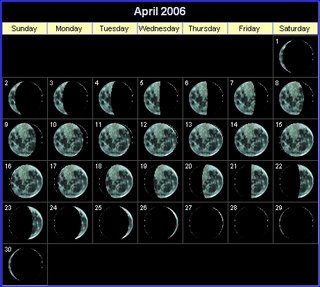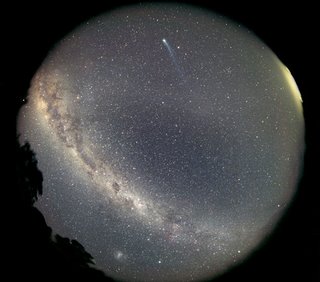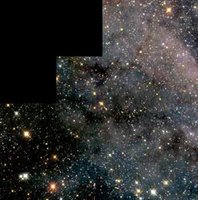 Antipodal Moon
Antipodal MoonYesterday evening, Jay & I were walking along a high ridgeline in the parkland behind our house as the sun was setting. As we came around a bend, my eyes focused on the quarter moon's brilliant white semi-circle directly ahead of me, and I stopped dead in my tracks. My brain struggled to make sense of what I was seeing. The moon was facing the wrong way!
Now some of you may not understand what I mean by this. You may also wonder how it is that I've lived in NZ for over two months without ever noticing the moon. Let me explain: when I was little, I learned a handy rule for remembering the moon's phases when it is waxing and waning. "If you draw a vertical line closing the moon's crescent, it will form either a 'p' for premier - first - or a 'd' for dernier - last." As a budding francophile, I immediately learned this by heart, and I have never been at a loss to know whether I am seeing the first quarter or the last quarter of the moon.
Since arriving in NZ, I have seen moonrise in the dusky rose of sunset, with the full moon blossoming fat on the far ridges of the Rimutakas.
 I have noticed the increased brilliance of the city's already bright stars on the nights of the new moon. I have glimpsed the crescent moon here and there in the sky without pausing to consider its celestial context. It was only last night that I finally, viscerally, realized that I am seeing the moon from a new perspective.
I have noticed the increased brilliance of the city's already bright stars on the nights of the new moon. I have glimpsed the crescent moon here and there in the sky without pausing to consider its celestial context. It was only last night that I finally, viscerally, realized that I am seeing the moon from a new perspective.[The graphic you see moving above is how I have been used to seeing the moon. In the southern hemisphere, imagine playing the film backwards. See chart at right.]
A similar experience occurred soon after I arrived here. One of the things I looked forward to with the greatest anticipation was the prospect of seeing the stars of the southern hemisphere.
 The New Zealand of my imagination nestled beneath strange stars, entirely unknown to me. On a first clear night, I was shocked to see familiar Orion above me, doing a handstand, upside down! For a few moments I felt entirely disoriented, not because of Orion's novel position, but because he was visible at all! I had looked at the same stars above my home in Minneapolis just a week before. Traveling all this way had failed to take me out of their sight.
The New Zealand of my imagination nestled beneath strange stars, entirely unknown to me. On a first clear night, I was shocked to see familiar Orion above me, doing a handstand, upside down! For a few moments I felt entirely disoriented, not because of Orion's novel position, but because he was visible at all! I had looked at the same stars above my home in Minneapolis just a week before. Traveling all this way had failed to take me out of their sight.This makes sense once you think about it - we see more than just the sky directly above us at 45 degrees latitude.
If you live at 40 degrees north latitude, and if you have an unobstructed view of the southern horizon, it's theoretically possible to see a star that would be overhead for someone at 50 degrees south latitude (40 + 50 = 90). From our view, such a star would be kissing the horizon. ...The point is, just because we're in the Northern Hemisphere, it doesn't mean we can't see stars in the Southern Hemisphere. We just can't see the ones that are more than about 80 degrees or so of our latitude. [source]Our angle of view isn't so different from what we left behind, so we continue to share many of the same stars with those of you back home. However, the Big Dipper is gone, as is Cassiopeia. Perhaps you are curious to learn: What does our sky have that yours doesn't?
 For one thing,
For one thing,All-in-all, the northern sky is rather devoid of light. By contrast, in the Southern Hemisphere, there are 11 constellations which are circumpolar and 6 first order magnitude stars! [source]We have noticed that the stars are incredibly bright here, with the Milky Way visible even inside the central city. Whether this is due to brighter stars or cleaner air is hard to say. If you're interested, here's a link to get you started on learning the stars down under. And maybe you'll even be inspired to pack your bags to come see the antipodal sky.

1 Comments:
This was a very cool lesson in northern and southern starness, answering questions I've had for a while. Thank you. Nice Moon, too. Thanks. Bill
Post a Comment
<< Home